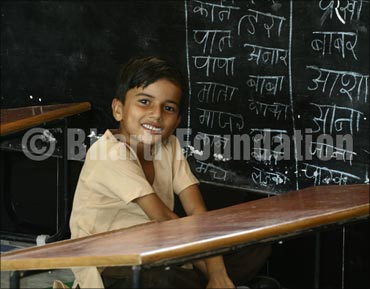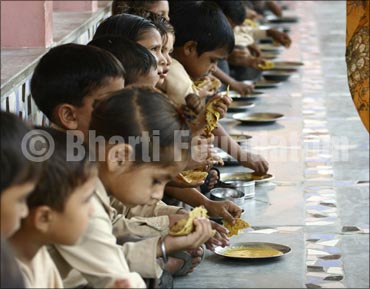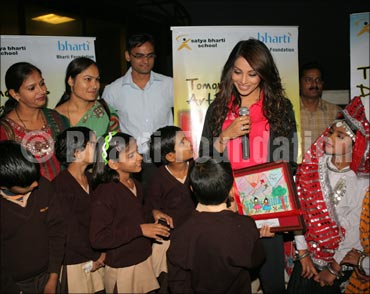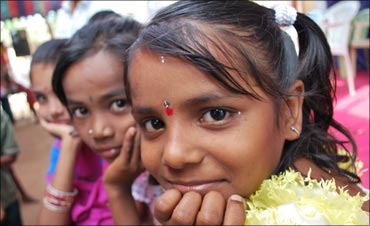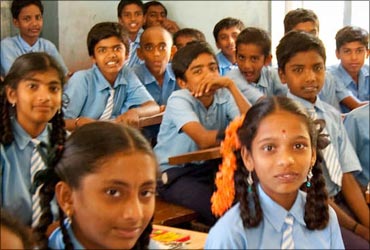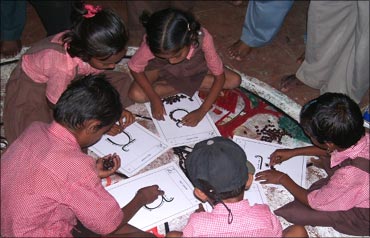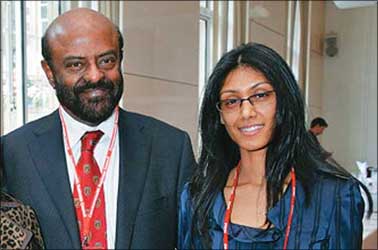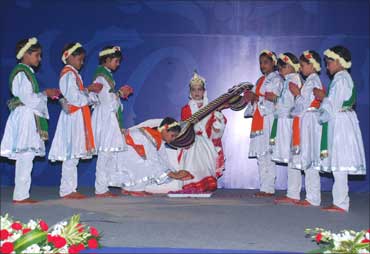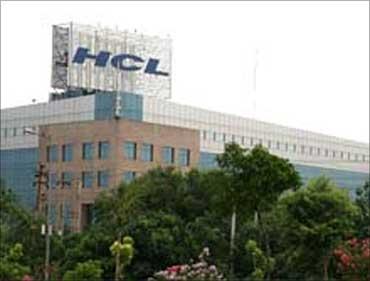 | « Back to article | Print this article |
How India Inc is funding primary education in India
Satya Bharti School, Nangal Mundi, has just three classrooms for the students of classes I to V who study here in two shifts. But the rooms are large, airy and clean, and decorated with colourful cut-outs of alphabets and fruits.
The school has six teachers who use aids such as flash cards and instructional CDs played on laptops to teach the around 130 children on the rolls. There's a well-tended lawn, a sand pit and a computer that students are allowed operate on their own.
The toilets -- separate for boys and girls -- are squeaky clean. How many primary schools in even the big metros can boast of all these facilities?
Nangal Mundi, however, is no city or even a town; it's a village of 2,000 on the cusp of rural and urban in Haryana's Rewari district.
Satya Bharti School, too, is no private school charging hefty fees, but a charitable one run by the Bharti Foundation, the philanthropic arm of the Mittals, for poor students.
Click NEXT to read on . . .
How India Inc is funding primary education in India
It is vastly superior to the Government Primary School just 50 metres away, where all but one of the dark and stuffy classrooms are locked, and students from classes I to V are taught in one group by a single teacher.
Students don't have textbooks because the government issues are yet to reach, and all that they get as midday meal is a thin broth of porridge with some milk and sugar.
The meal served at Satya Bharti School looks hearty in comparison -- roti, chana and aloo-subzi.
"If India has to be the backyard for providing workforce within the country and the world, then education needs to be taken deep into rural India," says Rakesh Bharti Mittal, co-chairman of the Bharti Foundation.
And how effective has the effort been? "In Neemrana, when we first took in students they had bleached hair. But one year in the school and it started turning black, because the mid-day meal the children were getting was probably their only nutritious meal in the day," says he.
Click NEXT to read on . . .
How India Inc is funding primary education in India
Mittal also points to the high 96-98 per cent that Satya Bharti students have scored in board examinations in Punjab, Haryana and Rajasthan.
Little Mahima and Ravina at Satya Bharti School in Kohrar, in a remote corner of Rewari, are examples of the transformation education can bring.
Daughters of a small trader and a farmer, respectively, whose fathers had studied till class X and mothers never went to school, the class V students are at the computer, rearranging jumbled-up sentences in English -- shuffling "wall the boy on sat the" to "the boy sat on the wall" -- clicking on each word and dragging it to its right place in the sentence.
Their summer vacations are kept short -- they may otherwise forget all they have learnt in school.
Companies have for long run schools near their factories for the children of their staff. But that's corporate social responsibility, not charity, and hence not scalable.
Click NEXT to read on . . .
How India Inc is funding primary education in India
Things have taken a turn for the better now. Indian businessmen, made rich beyond belief by the stock market boom of the last seven years, are moving in to plug the gap in primary education.
Pratham, an NGO which works in education, has received large donations for several years from high net-worth Indians, or their companies, including Mukesh Ambani, Ajay Piramal, Rohini Nilekani, Gautam Thapar and Kumarmangalam Birla.
(Even so, "individual and corporate donation make up only 10 per cent of the charity in India" says Bain & Company's 2010 India Philanthropy Report. Indian businessmen seem parsimonious compared to big donors abroad like Bill Gates and Warren Buffet.)
The problem in education is complex. The numbers are there, alright. Nearly 96.5 per cent of children in India now go to school. Social scientists will tell you it's because of the free mid-day meal.
But the dropout rate in primary classes has remained a high 24.93 per cent. More than that, it is the quality of education that is the cause for concern.
Click NEXT to read on . . .
How India Inc is funding primary education in India
Pratham's 2010 Annual Status of Education Report found that only 53 per cent of children in class V could read a simple text, and 36 per cent could do a simple division sum.
That was the thought behind setting up Satya Bharti Schools. In four years, the Bharti Foundation has set up 242 primary and senior secondary schools in six states -- Punjab, Haryana, Rajasthan, Uttar Pradesh, West Bengal and Tamil Nadu -- which reach 31,000 children, 48 per cent of them girls.
By end of this year, Mittal aims to have 250 schools. Bharti Foundation has a team of 140 employees, besides the teachers and staff in schools, headed by a CEO to run its operations.
It is bankrolled by the Rs 200-crore (Rs 2 billion) endowment by the Mittals (Sunil Mittal and his family, according to Forbes, were worth $8.3 billion in 2010), with some help from others like Kalpana Morparia, the DLF Foundation and, recently, Google.
Funds shouldn't be a problem for the Azim Premji Foundation either, to which Wipro founder Azim Premji (worth $16.8 billion) transferred 21.3 million of his own shares late last year.
Click NEXT to read on . . .
How India Inc is funding primary education in India
The Azim Premji Foundation works in the area of elementary education, but its approach is different from that of the Bharti Foundation.
Instead of opening and running schools, the Azim Premji Foundation works to augment capacity and iron out systemic glitches in government schools, given that these are where most poor Indians send their children.
Having started out in 2001, it has worked with 20,000 schools and 2.5 million children across 13 states to date.
In a way, the Azim Premji Foundation's entire programme has evolved out of an initiative called the 'Learning Guarantee Programme', which was launched in 2002 in 1,000 government schools in seven districts of north-east Karnataka which accounted for half the out-of-school children in the state.
Click NEXT to read on . . .
How India Inc is funding primary education in India
It was a simple programme to identify the best schools in these districts and showcase them, so that they could become lighthouses for neighbouring schools, explains S Giridhar, the foundation's head for programmes and advocacy.
Schools were assessed, there was recognition and a cash award -- Rs 5,000 to Rs 20,000 -- for the best ones, who had to specify what they were going to spend the money on. A team would later check if the money had indeed been used for that purpose.
The programme spread fast: within two years, Karnataka had decided to implement it in 30 schools in each block, Madhya Pradesh in 1,654 schools in two districts, Uttarakhand (a year later) in 400 schools (now increased to 780 schools), Gujarat in 970 schools, and Rajasthan in 1,080 schools.
The Azim Premji Foundation has, over the years, worked on other initiatives as well. It has created workbooks for classes I to VIII in Rajasthan, and trained teachers in how to use these. Since 2004, it has also been conducting a pilot project on a 'child-friendly school' in Shorapur in Yadgir, a district in Karnataka very low on human development.
Click NEXT to read on . . .
How India Inc is funding primary education in India
The logical next stop was the Azim Premji University which has started taking in students this year. "As we worked with the government, we realised that one of the biggest problems was the paucity of teachers," says Giridhar.
So the university, spread over 75 acres near Bangalore, will offer courses not in engineering or computes but in education and development. "We want to groom passionate professionals who will go down to the ground and work," says Giridhar.
VidyaGyan, run by the Shiv Nadar Foundation, set up by Shiv Nadar of HCL (net worth $5.6 billion), is not just a a school, it is a radical experiment in social engineering.
All students at VidyaGyan come from poor households with an annual family income of less than Rs 1 lakh (Rs 100,000). But they are all academically bright -- having come first or second in the state-conducted class V examinations.
Click NEXT to read on . . .
How India Inc is funding primary education in India
But it's not just the education that's catered to. In order to equip them to compete with urban students, every aspect of their lifestyle is sought to be transformed.
All students are given a 'kit' when they come in, which has school uniforms, nightsuits and sports uniforms, T-shirts and shorts, undergarments, shoes, slippers, toothpaste and everything else they might need.
There are posters in the bathroom telling them how to use the amenities. (Nadar's wife Kiran and their daughter Roshni were involved in the project, down to designing the bright, cheerful uniforms.)
They are then sent for a medical check-up and put through a vaccination regimen. Their meals include milk, eggs, cereals, lentils and non-vegetarian food four times a week.
Click NEXT to read on . . .
How India Inc is funding primary education in India
No wonder, says B Banerjee, VidyaGyan's principal, they gain five to six kg and two-three inches within the first few months.
Besides students at VidyaGyan have access to audio-visual learning and computers aids, they watch television and films, listen to music, play games and take part in theatre, choir singing, debates and quizzes.
Teachers double as mentors to address any adjustment problem the children may have. Remarkably, in the past two years, only one child did not come back after the summer break.
"There has also not been one single incidence of damage to school property. These children are disciplined, they value what they have got," says Banerjee.
Click NEXT to read on . . .
How India Inc is funding primary education in India
Shiv Nadar Foundation has been around since 1996, setting up engineering and management colleges. But it is only with the opening of VidyaGyan in Bulandshahr in August 2009 that its philanthropic aspect has come to a head.
"As HCL grew," says Nadar, "so did my desire to give something back to society. As I pondered and thought about what could make India shine, I looked at myself and asked, 'What am I?'-- I'm a product of education."
Nadar last year sold 2 per cent in HCL Technologies to raise Rs 580 crore for the foundation. Two more VidyaGyans will come up in Sitapur and Varanasi.
"I do not like the word philanthropy as it gives a sense of being on a pedestal. I get inner peace in giving," says G M Rao, who endowed GMR Varalakshmi Foundation with $340 million this March.
Click NEXT to read on . . .
How India Inc is funding primary education in India
"Those of us who have been able to create significant wealth are the fortunate ones in a position to help those who have not been so fortunate. These are values I received from my parents. Even at school, I would be sharing everything from books to food," says Rao, who is worth $2.6 billion, according to Forbes.
The GMR Varalakshmi Foundation has been around as the CSR arm of the group since 1991, working in areas where the company had infrastructure projects under way.
Education, especially primary education and vocational training, is a key thrust area and the foundation has built schools and supports government schools -- building a toilet where needed, or a science lab or library, besides giving out scholarships to the meritorious but poor students.
It has worked with 200 government schools reaching out to 28,000 children so far. The foundation also recruits and trains locals to help out in schools with a poor pupil-teacher ratio; runs night schools, tent schools and manages and supports 129 Balwadis and Anganwadis benefiting 3,000 pre-school children.
A small step in the right direction.
